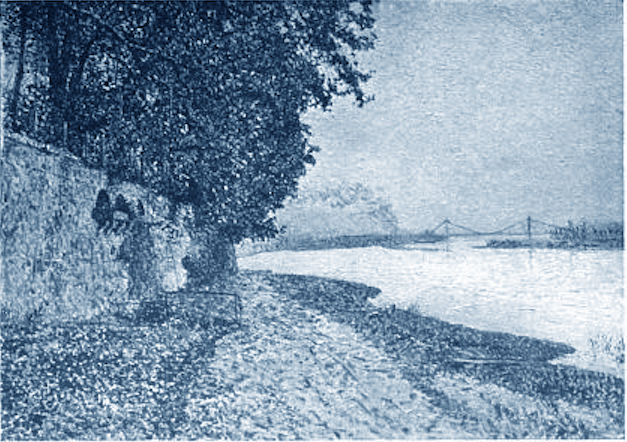From reader Lutz Mauersberger from the Berlin-Mitte Archiv I received a comment on before's Käthe Münzer's "Herculesbrücke" posting. The following account of my initial "research" renders some clues and insight but raises also more questions, it is an ongoing project. Like Fanny Remak, Eugenie Fuchs is largely forgotten today although both were taught (influenced and surrounded) by the leading painters of the period.
Fuchs, Eugenie Caroline
(25-06-1873 Berlin-Charlottenburg –
murdered in Majdanek concentration camp Poland)
German painter
German painter
Wannsee near Berlin by Eugenie Fuchs
and by Max Liebermann who build a villa on its shores and by Lesser Ury. Both were Jewish, impressionists and world famous. Max Liebermann obstructed Ury's career fearing his talent might be greater then his (he burned Ury's wings, like Icarus, when and where ever he could). Comparing these Wannsee impressions it becomes obvious what a fine painter Eugenie Fuchs was.
Eugenie Fuchs was like Fanny Remak and Käthe Münzer a Jewish landscape and portrait painter and had been a student of
Franz Skarbina (1849-1910), Walter Leistikow (1865-1908) and Lovis Corinth (1858-1925).
Then she moved to Paris for further studying. Sadly it is not known and unmentioned with whom she studied and in what year she returned to Berlin. In Berlin the house she owned (1933) a 1/4* of by heritage, Schlossplatz 5 was confiscated by the Nazis in 1941. (
* 1/4 by Dr. Gerhard Fuchs a nephew who probably was killed in car accident in the 1930's and 1/2 by Gertrud Fuchs, her sister-in-Law who possibly wasn't Jewish, possibly explaining why their share wasn't seized by the Nazis). Eugenie never lived here, the building probably had been bought by her father as an investment. Her parents lived at Kronprinzen-ufer 22, north of Tierpark and around 1876 he was the Consul of Honduras in Berlin.
* 1/4 by Dr. Gerhard Fuchs a nephew who probably was killed in car accident in the 1930's and 1/2 by Gertrud Fuchs, her sister-in-Law who possibly wasn't Jewish, possibly explaining why their share wasn't seized by the Nazis). Eugenie never lived here, the building probably had been bought by her father as an investment. Her parents lived at Kronprinzen-ufer 22, north of Tierpark and around 1876 he was the Consul of Honduras in Berlin.
She had fled to Paris in 1933, banned from working by the Nazis, in the same year as Käthe Münzer (1877-1943). In Paris she exhibited with Käthe Münzer (1877-1943),
Eugen Spiro(*) (1874-1972), Victor Tischler (1890-1951) and Fred Uhlmann (1901-1985), refugée artists meeting in the Café de Dôme circles.
(*) Eugen Spiro in 1903 married famous actress
Tilla Durieux (1880-1971) (above by Franz von Stück). In 1906 they were divorced and in 1910 Durieux married Berlin art dealer
Paul Cassirer (1871-1926)(above) who exhibited 4 of Fanny's works (I shall discuss those later) along with 30 by French impressionist Camille Pissaro (1830-1903) in 1907. Cassirers world famous Art Gallery was located in Viktoria-strasse in the Tiergarten area and next door to the studio of Max Liebermann.
Schlossplatz nr. 6-1. Kaiser Wilhelm's city palace is opposite (the palace is now being rebuild). On Nr. 3 was Lagergren Conditorei & Café, popular and visited by Scandinavians ("and mainly women") according to an early 1900 Baedeker tourist & city guide.
Scandinavian immigrant Ryno Edvard Lagergren (b. 1855) married Gertrud Schmidt (b.10-07-1875) in 1901 and owned the Café and Conditorei.
Georg Leisegang(link) ran a drugstore and photo studio on nr. 4 (but later seems to also occupy the shop/ground level of nr. 5) advertising widely and frequently in Berlin's newspapers (Schlossplatz 4/5). Before Leisegang, at nr. 4, advertised also selling perfumes as can be read in the older lower photograph. The company that evolved after WW2 is still existing (in the US) building specialist medical optical equipment. All was completely destroyed by bombing in 1945.
After ten years of living in Paris she was seized in 1943 in a “Nacht und Nebel” (night and fog) operation, the preferred and perfected method of the Nazis to get rid of the resistance, dissidents, gypsies, homosexuals and Jews. She was interned in notorious Drancy internment camp North of Paris, transported to Auschwitz and later murdered, aged 70, in Majdanek death camp.
She had been a member of the "Verein der Berliner Künstlerinnen" (VdBK) 1927-1933, exhibited with the VdBk 1927-1930 and with “Das Kind” 1930, 1932-33).






























.png)

























%2B.jpg)




